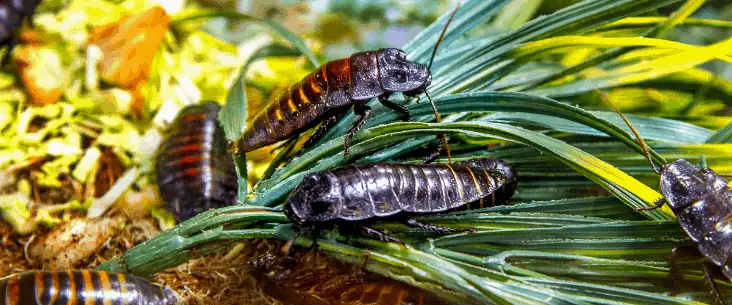Probably you have never considered keeping a cockroach colony as pets. Yet, cockroaches can make great pets. And one of the most popular species of them all is the Madagascar hissing cockroach. They are easy to keep, easy to handle, beautiful in colour and shape, and impressive to see.
Madagascar hissing cockroaches make a perfect starter pet. They are exceptionally easygoing as a first pet for your kids, but all ages keep them. In this care sheet, we will have a look at how to set up a cockroach exhibit and how to take care of these great bugs.
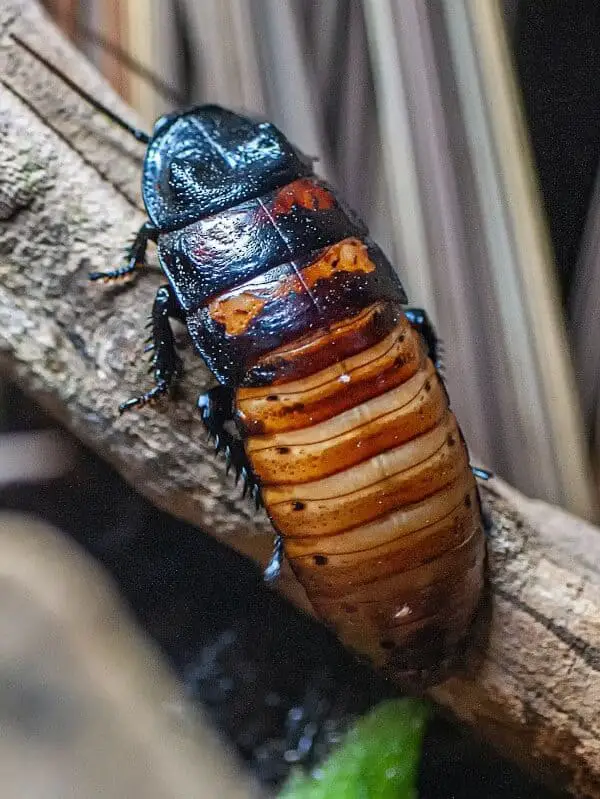
About Madagascar hissing cockroaches
Madagascar hissing cockroaches, also called hissing cockroaches or simply hissers, is one of the largest species of cockroaches. They are beautiful brown coloured on their exoskeleton and cover their whole body, only six legs and two antennas our sticking out.
However, these cockroaches are mostly known for the hissing sound they can make. They press air through respiratory openings (called spiracles) on their abdomen. They use various types of hissing sounds. One call is for when they are feeling threatened, one call to attract a mate and another call is for warning to males when a male is ready and preparing to attack for the right to mate. Fun fact: every hissing cockroach has its own characteristic sound. Hissing cockroaches can distinguish the sounds between different individuals.
Cockroaches like to be in a colony so it would be best to keep several individuals together. We always talk about keeping a colony instead of keeping one individual. You don’t need to keep them by the hundreds. If you want a small colony, you can already start with six hissers housed together, but keep in such situation more females than males. Males are territorial and may keep attacking each other.
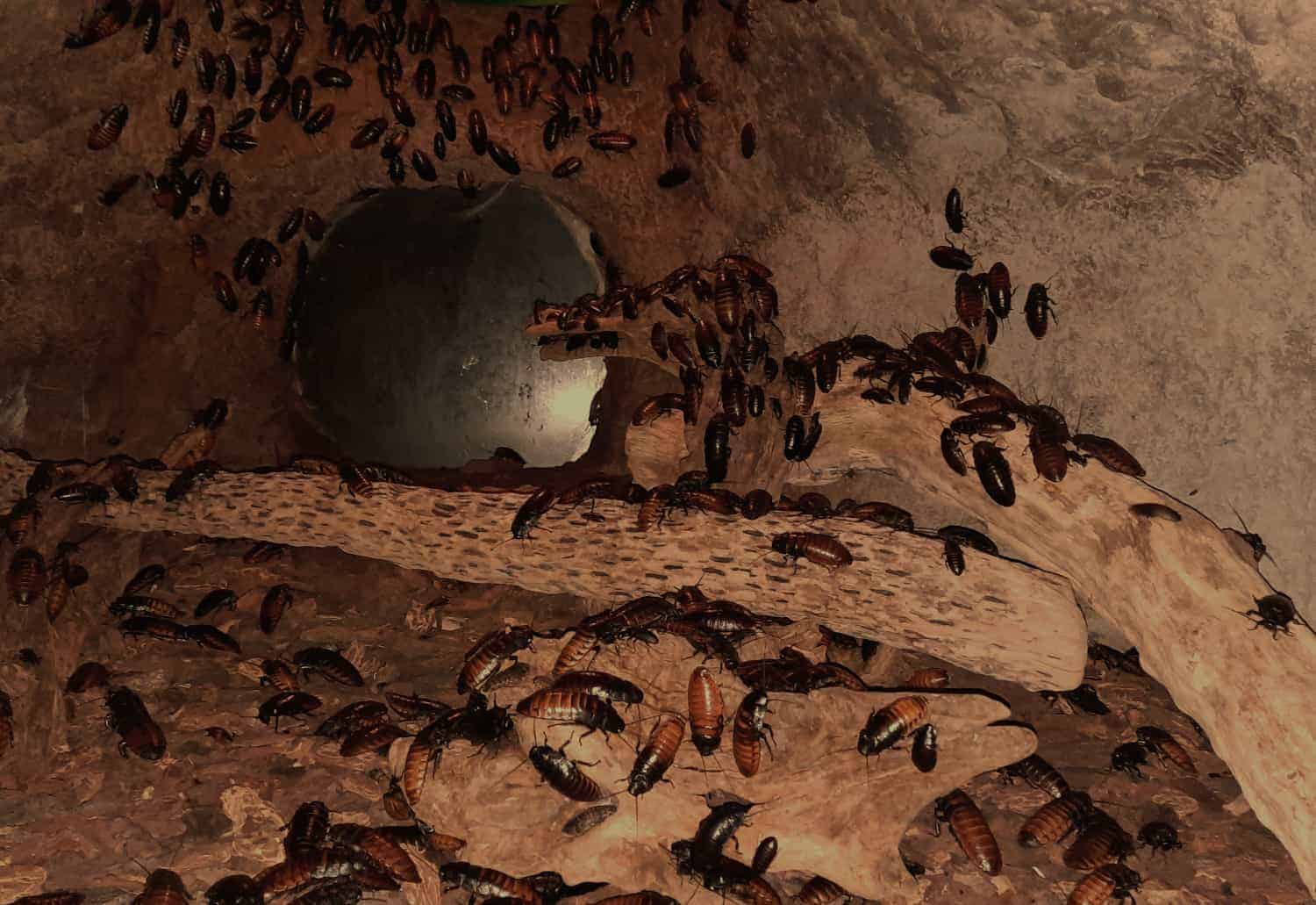
How to keep Madagascar hissing cockroaches?
Caring for hissers is very easy. When you set up the right enclosure and a proper habitat, they will flourish, and you can easily breed with them. Let me help you to create the perfect hisser habitat.
Enclosure setup
Madagascar hissing cockroaches can be housed in simple aquariums, DIY enclosures or reptile terrariums. Despite that they don’t have wings and can’t fly, they are excellent climbers and can even climb up the smooth glass. So make sure they enclosure have a lid or can be closed off in some way.
Hissers don’t need much space. You can house ten hissers perfectly in a small glass aquarium with a size of 20cm by 20cm. It is better not to go any smaller. When you have more space, you can house larger colonies, but when starting with ten hissers and a little patience, you’ll have soon enough over 100 cockroaches.
If you have a closed space for your cockroaches, make sure there is enough ventilation. You can make a lid of fine metal mesh. Ventilation is essential for the well-being of the cockroaches and prevents the build-up of nasty smells.
Cockroaches do like a thick layer of a substrate. You can use many types of substrate, like cocos-humus, coco peat, peat, soil, wood shavings or wood chips. I like to use large wood bark chips to fill up the enclosure. This way, it also creates mini shelters for smaller cockroach nymphs or places for females to produce offspring.
GOOD PRACTICE TIP: Make sure that all substrate and furniture is free of pesticides and fertilize. These chemicals can quickly harm you cockroaches what result ultimately in death.
Hissers are primarily nocturnal, and they prefer to have enough places to hide and shelter. Provide branches, wood, cork or other decorative pieces, so they have places to hide from the light. Mostly when they mould, they prefer a safe place to do so because at that moment they are very vulnerable. Other equipments that can be used to furnish the enclosure are toilet paper rolls, egg cartons, driftwood and small cardboard boxes.
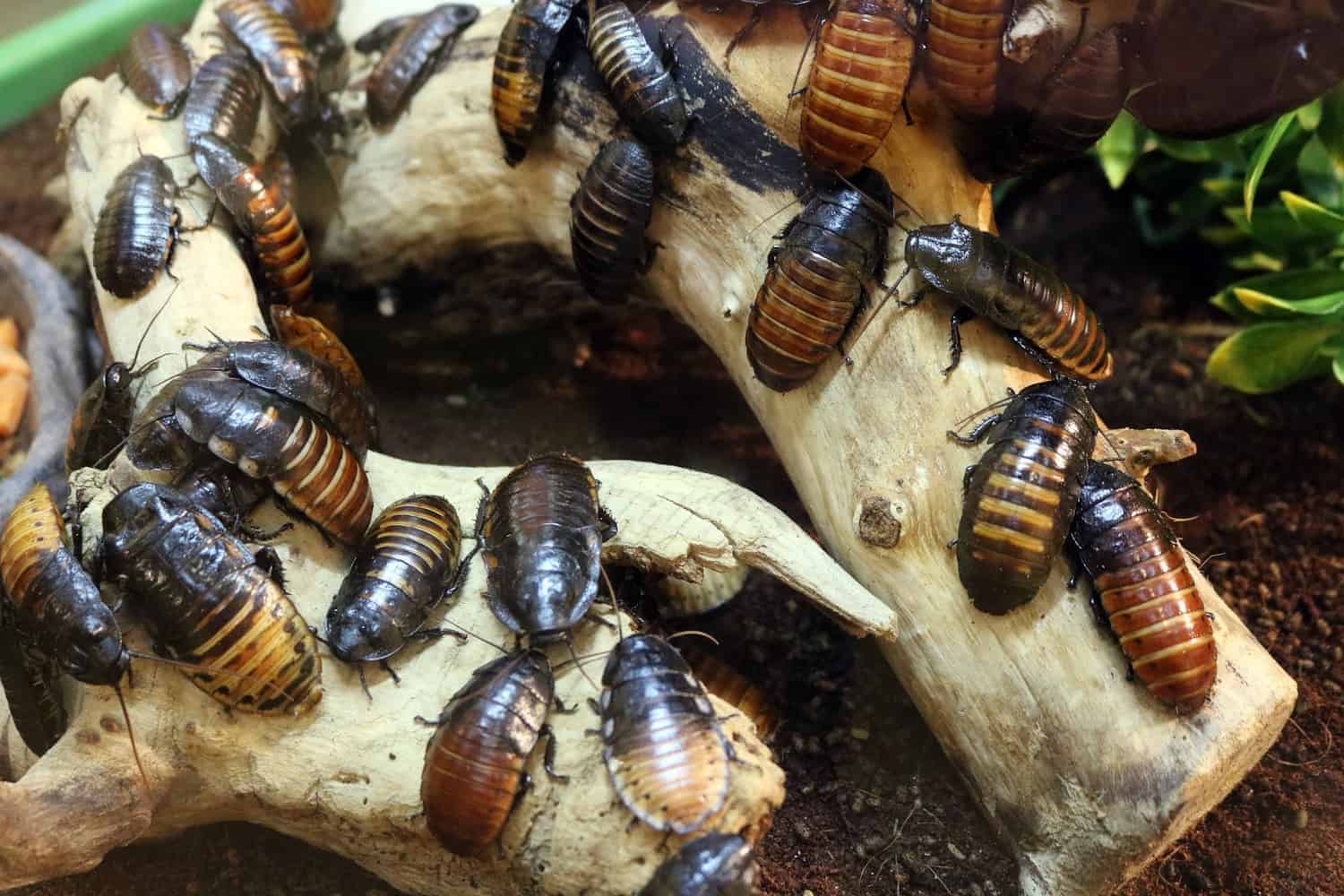
Habitat
To house Madagascar hissing cockroaches comfortably you’ll need to make the perfect habitat. As they are tropical cockroaches, they are best kept at a temperature around 25°C – 28°C (77°F – 82°F). At night, you can let it cool down to a minimum of 21°C (70°F). They need these temperatures to allow the metabolism and immune system functioning properly. With breeding, you’ll absolutely have to keep the temperature around 27°C-28°C for most breeding success.
You can heat the enclosure by using simple light bulbs. Place them above and outside the enclosure to prevent that cockroaches or furniture can get burned. You’ll need to experiment which wattage would fit in your situation to create the right temperature range. When you connect them to a timed switch, you can create day and night temperature, and at the same time, a proper light cycle. A 12h:12h cycle would be just perfectly fine.
Hissing cockroaches also need high humidity. Higher humidity helps them with moulting (shedding their outer exoskeleton) and for the development of eggs and nymphs. Keep the humidity between 65% and 80% so they will thrive the best. Keep the substrate damp (not wet) by misting water frequently. Misting should be done daily or every other day.
Buy a simple thermometer and hygrometer (often available in the same device) to monitor the temperature and humidity inside the enclosure. When monitoring environment, you know how well the habitat suits the cockroaches. When you do not reach the right temperature or humidity, you can make small changes to your setup.
Cleaning
Cleaning the enclosure is not much effort, but it is absolutely necessary to do this regularly. Make sure you remove uneaten food, shedded skins and dead cockroaches at least every other day. When you use a food or drinking bowl, clean them as well by rinsing them with water.
The substrate needs to be refreshed too once in a while. You can remove dirty spots every month, or replace the substrate in full every six months. If you do not regularly refresh the substrate bacteria and mould will grow, which in turn in unhealthy for you cockroach colony.
Never use any chemicals in proximity to your cockroaches, or use chemicals to clean the enclosure without removing the cockroaches from the enclosure. Chemicals will quickly kill your cockroaches, but even damps or remains of it can be lethal to the cockroaches. Always clean with (hot) water or, when you remove the cockroaches from their enclosure, you can use chemicals. However, make sure you rinse it extensively afterwards to be sure there are no remains.
What to feed Madagascar hissing cockroaches?
Madagascar hissing cockroaches are primarily herbivores. Feed your hissers a variety of fresh vegetables and fruits. You can feed them leafy greens (but avoid iceberg lettuce), carrots, tomatoes, peas, celery, apples, bananas, oranges and potatoes.
You can also add dry food to this diet. Think of pellet food for dogs. You can make the pellet food wet, so it is easier for them to eat and digest. And in this way, you also provide drinking water. You can also use oats flakes to feed them.
It would be best if you remove, at least, the food every other day. Hissing cockroaches, unlike other cockroaches, only eat fresh fruits and vegetables. The uneaten food will start quickly to moult when left in the enclosure. Feed them from a bowl, so the food or particles of it will not disappear in the substrate where it can rot.
Hissing cockroaches can extract much water from their fresh food, but it is good to provide a drinking bowl as well. Make sure this bowl is shallow and have low edges, so cockroaches can easily climb in or out. It would even be better to use a sponge (make sure it does not contain chemicals!) to prevent the small nymphs from drowning in the water bowl. Best would be to refresh the water bowl every day.
How do Madagascar hissing cockroaches reproduce?
Even with a lifespan up to 5 years, I can imagine you want to breed with them in the future. For example, to make sure that when your first adults die of old age, you still have cockroaches left in the enclosure. Breeding Madagascar hissing cockroaches is rather easy when you provide them with a good-sized enclosure and a proper habitat and climate.

Next, you’ll need to make sure that you have males and females. They can’t produce offspring without mating.
You can easily distinguish the difference between males and females. Males have large horns, kind of “bumps”, on the front of their exoskeleton (behind the head). They use these horns to fight other males and give them an impressive look. Females have no to small little bumps. Also, the antennae of males are thicker and hairy, while the antennae of females are relatively smooth.
Hissing cockroach life cycle
Madagascar hissing cockroaches can reach sexual maturity as early as 3 months, but most will start breeding when 5 or 6 months. They are not particularly fast breeders. A female will have up to 3 litters every year, with around 20 to 30 little nymphs.
Eggs
The eggs packages, called an ootheca, are inside the body of the female until they hatch. It takes around 60 days before the eggs will hatch. This way it looks like the cockroach will give birth to live nymphs, but instead, they hatch from eggs.
Nymphs
The little newly hatched nymphs are bright white, but turn dark when their exoskeleton hardens and dries. Nymphs moult six times, and it takes up to 6 months, to develop into an adult hissing cockroach. Every time they moult, they are bright white, and it takes some time before their colour return. At that moment, they are very vulnerable and often will hide and retreat in their shelter.
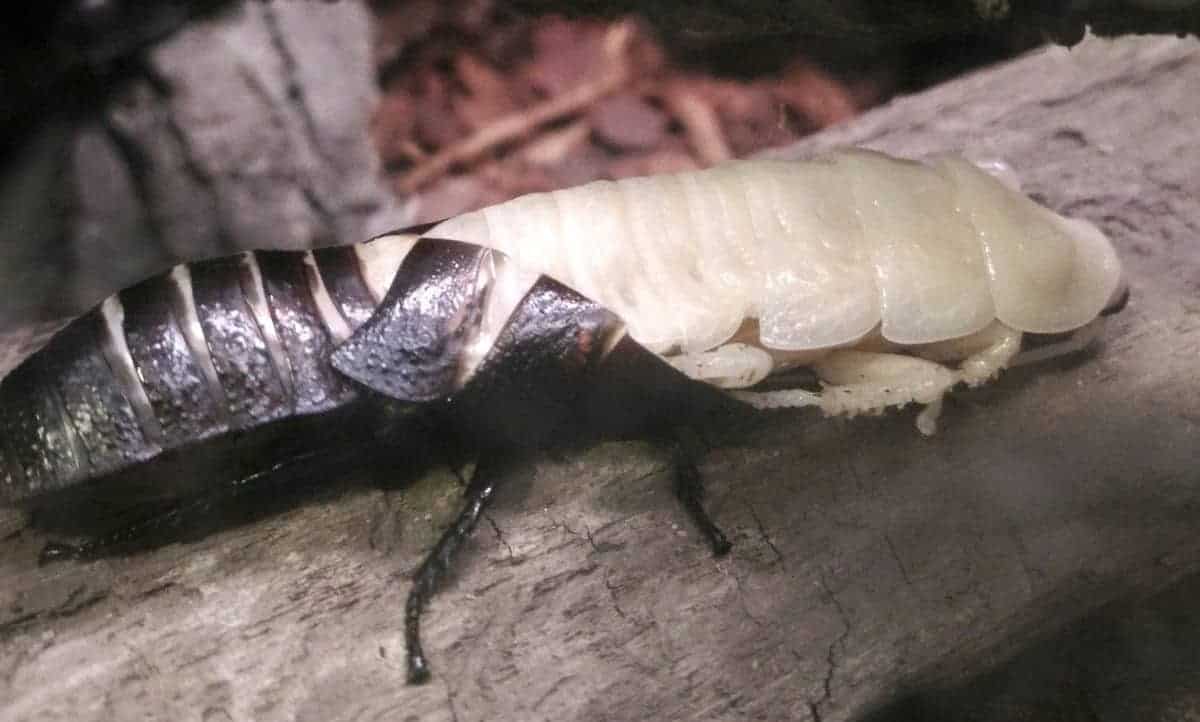
Adults
After reaching adulthood, they stop moulting, and they won’t grow anymore. Females start to reproduce after mating with a male. A female can lay up to 750 young in her life when kept in proper conditions.
Where can you buy Madagascar hissing cockroaches?
Many pet stores and reptile expos are selling Madagascar hissing cockroaches. They are quite easy to get, and they are not expensive to buy. Price ranges from $4 up to $8 per individual, although when you purchase multiple individuals, you often get a certain discount.
Be aware that species of the same family are often sold as Madagascar hissing cockroaches, although they are slightly different in size and appearance. Despite being different species, the way you keep and care for them are (almost) the same.
Madagascar Hissing Cockroaches FAQ
Other bugs similar to Madagascar hissing cockroaches to keep as pets
Madagascar hissing cockroaches make excellent pets. Do you like these hissers, you’ll probably be interested in the other bugs mentioned below, too. I can recommend you to check them out. You can find more bug species on the page ‘Choose your bug species‘.
Do you have any questions about the Madagascar hissing cockroaches, please ask on the contact page.
Share this page!

